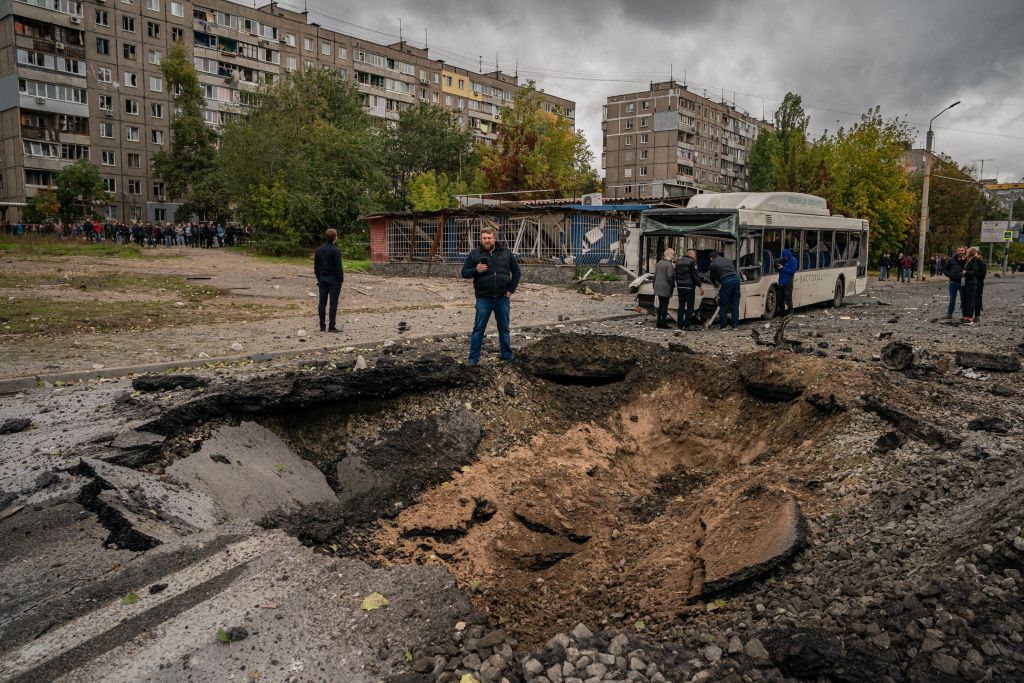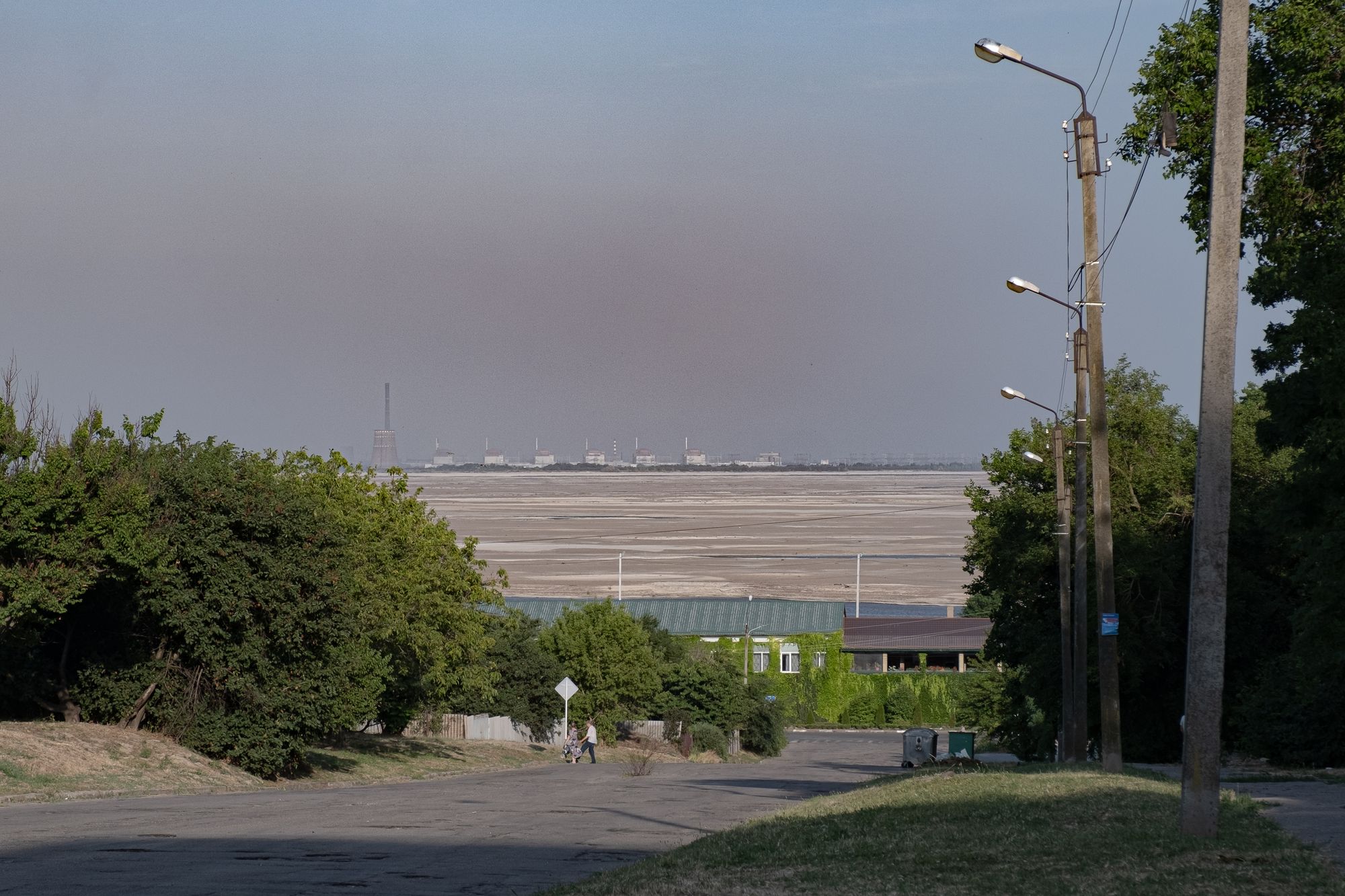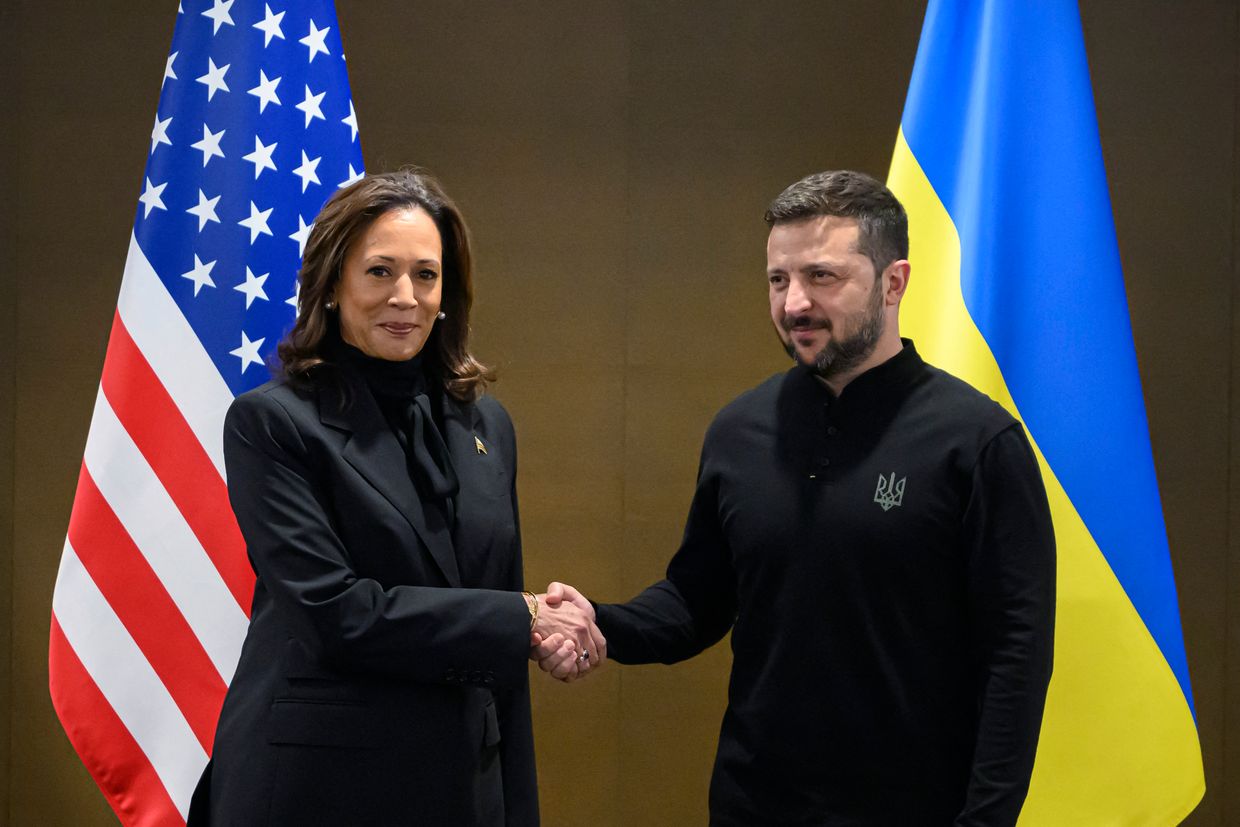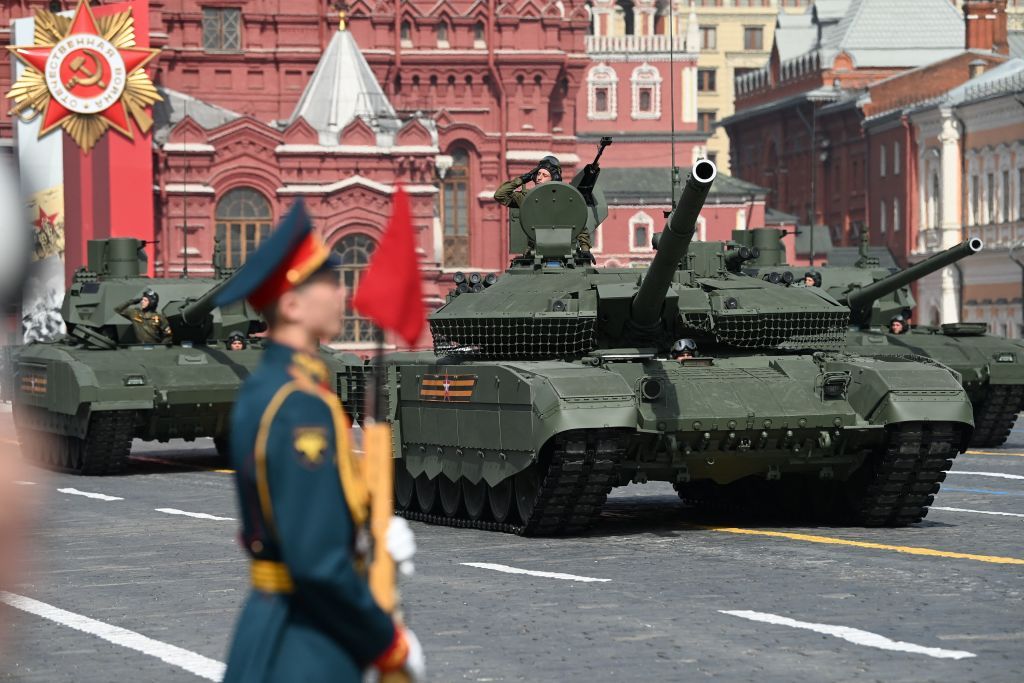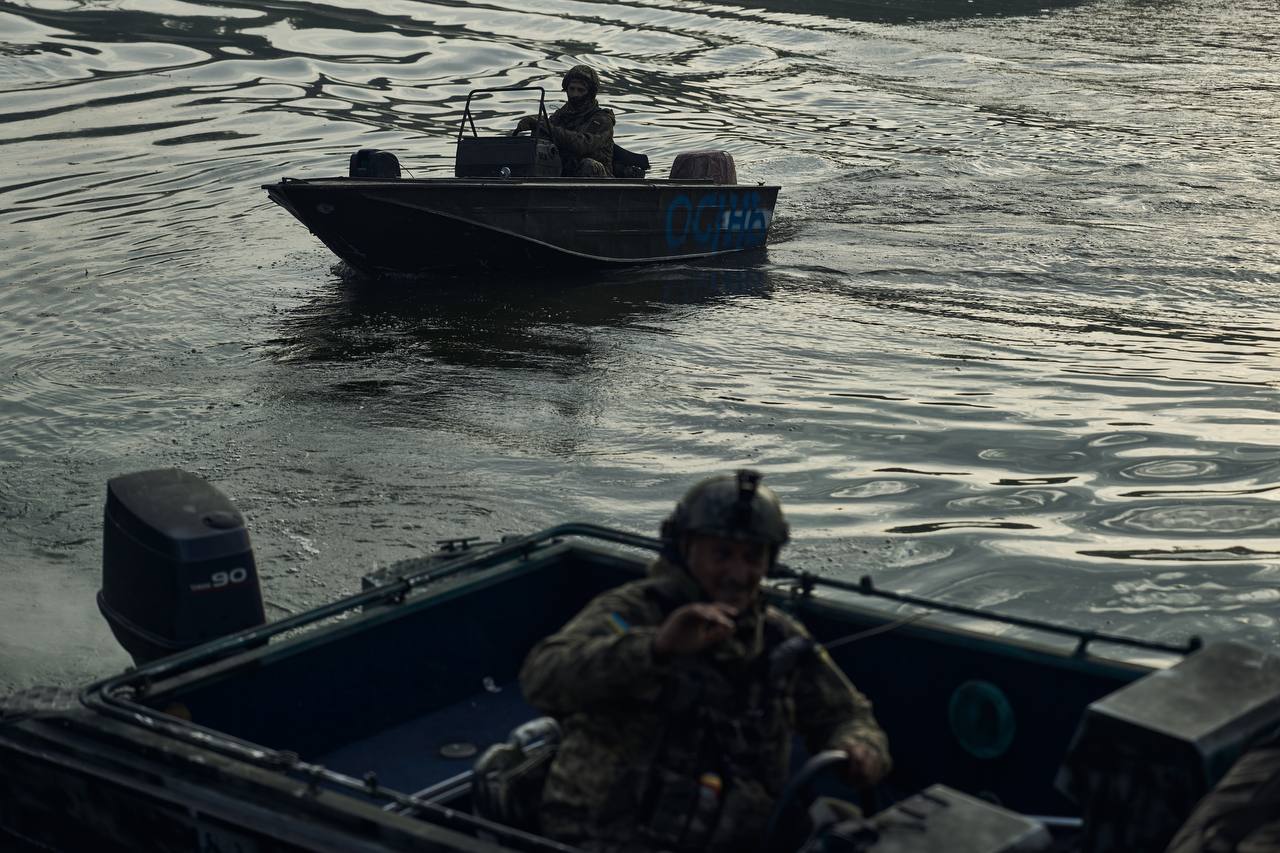Russia lashed out on Oct. 10, striking many Ukrainian cities with 84 missiles and 24 exploding drones.
The places they hit were all civilian — multiple power plants but also a children’s playground in the center of Kyiv. Most strikes seemed to be timed to the Monday morning rush hour, as if trying to kill as many commuters as possible.
From a human rights point of view, the attacks were inexcusable and will likely be ruled as war crimes. From the battlefield perspective, the Russian armed forces just dropped hundreds of millions of dollars to achieve basically nothing.
“The invaders can't stand against us on the battlefield and thus resort to this terror,” President Volodymyr Zelensky announced on the evening after the bombardment.
This raises several questions.
Why has Russia chosen to do this? What was it trying to accomplish? And how long can it keep it up?
The facile answer is that Russia was retaliating for the partial destruction of the Kerch Strait bridge on Oct. 8. But that's just not true. It's been hitting civilian targets since Feb. 24. Ukraine's intelligence said that the missile strikes had been planned since the start of October.
"Strategic and long-range aviation units received orders to prepare for massive missile attacks,” the General Intelligence Directorate said in a statement. “The targets were objects of critical civilian infrastructure and the central regions of densely populated Ukrainian cities.”
The goal was to sow panic among Ukrainians. But that wasn’t the only reason. Putin also needed to appease the angry hardliners who want Russia to win the war. The war hawks demanded a massive strike just like this, in response to Russia’s humiliating losses over the past two months, to which the bridge was the exclamation point. Some of these hardliners are driven more by emotion than sense. And they will want a repeat performance.
Can they do it? Well, Russia had launched 3,500 missiles at Ukraine as of August, according to Zelensky. It’s hard to say how many it has left. The fact that it’s increasingly using older types suggests that the most advanced models are in limited supply.
With shortages of imported parts and skilled labor bottlenecking production, it’s unlikely that Russia can keep up with this rate of use for long. And Ukrainians are getting better at shooting them down.
To keep at it, Ukraine needs more air defense weapons if it wants to protect its precious infrastructure through the winter. This will depend on the response of Western allies to the latest attack. Kyiv is in talks with U.S. and European partners, trying to make it happen.
Why did Russia do it?
In very rough terms, Putin has to juggle two sets of people: the militant hardliners and the passive majority.
His recent moves — declaring the annexation of four oblasts, launching a disastrous mobilization, and raining missiles on civilians — show that he’s increasingly doing what the hardliners want and alienating the rest of the population.
“It looks like that because this is exactly what they were pushing for a long time,” said Russian sociologist Greg Yudin. “Both appointing Sergey Surovikin as the commander of this operation and these strikes targeting critical infrastructure.”
Russian propaganda networks celebrated the attack. Andrei Medvedev, deputy speaker of the Moscow city council, said Russian society had been demanding the strikes for a while. "But does this change a lot? If attacks on critical infrastructure become regular, if strikes on railroads, bridges, and power plants become part of our tactics, yes it does," he said on Telegram.
The hardliners also celebrated “Putin admitting that he kind of obeys them,” said Yudin. “This is not typical for Russia. Normally he wouldn’t do things that people are demanding for him to do, so as to not appear dependent.”
“It reached the point where they were implicitly threatening him. So he had to appease them at this point,” said Yudin.
Putin depends on them in part because they are the only ones that provide what he might see as a viable path forward, Yudin said. He added that watching the destruction in Ukraine is almost like therapy for the hardliners’ wounded pride.

Andrei Kolesnikov, a senior fellow at the Carnegie Endowment for International Peace told The Guardian the attack was "trivial (and)... personal revenge."
When Putin addressed the strike, he said that the Kerch Strait bridge explosion was "impossible to leave without a response."
Putin said the barrage was requested by his defense ministry, likely referring to Surovikin, the new Russian commander of the war in Ukraine, who's known for being a hardliner with no regard for human life. Indeed, infrastructure attacks are exactly Surovikin's style, according to GUR representative Andriy Usov.
What it accomplished
Besides helping hardliners feel some schadenfreude, the Russians hit power assets in 12 regions and the capital. Power outages took place in 15 regions, from Lviv in the west to Kharkiv in the east. Some parts of the capital saw blackouts.
Ukraine was forced to stop exporting electricity to Europe, which will increase pressure on European countries. Alina Frolova, a military expert with the think-tank Center for Defense Strategies, said this electricity mattered to them.
"It was the export of electricity from Ukraine that helped Europe reduce the consumption of Russian energy resources," energy minister Herman Halushchenko pointed out.
Across the country, 89 people were injured, with 11 deaths so far. A total of 117 sites were hit, dozens of which were residential buildings. Some civilian areas were deliberately targeted, such as in central Kyiv. The point seems to have been to inflict terror.
But if the objective was to terrify Ukrainians, it seems to have failed, based on the Kyiv Independent’s interviews with dozens of civilians in Kyiv and elsewhere. Most of them were calm and steady, their hatred of Russia undiminished but cool and rational, even those who lost their apartments. People sheltering in Kyiv subways sang patriotic songs.
“Ukrainians have developed a resistance,” said Frolova.
“Probably all it’s accomplished is to harden Ukrainian resolve and make it more likely that Ukraine receives better air defense more quickly,” agreed Phillips O’Brien, a professor of strategic studies at St. Andrew’s University in the U.K.
But military experts agreed that the strikes will have very little impact on the battlefield, where the exhausted and undersupplied Russian forces have driven back in the south and east of the country. With the loss of the Kerch Strait bridge railway, they can no longer be resupplied through Crimea. They now only have one supply line to Kherson and it’s in the HIMARS range.
The Kremlin’s attack also accomplished a draft law in the U.S. Congress to classify Russia as a terrorist state. And, after one missile hit an office of the German embassy in Kyiv, it got Germany to agree to send Ukraine weapons in the upcoming days.
Can Russia keep blasting Ukrainian cities?
It’s the debate that never ends: Is Russia running out of long-range missiles? There’s a plethora of articles on the subject. While we don’t know how many missiles it has, we can deduce one thing — Russia can’t keep casually throwing high-tech assets away by the fistful.
In the opening salvos of Russia’s war, modern missiles took flight, like the KH-101, the Kalibr, and the Iskander. But over the following months, Russia began increasingly mixing in older models, such as Soviet missiles from the 80s, then the 60s.
The Russians’ ability to inflict damage has been spotty. The early barrages failed to shut down Ukraine’s airfields and command and control centers when the country was at its most vulnerable. Over time, many missiles missed their targets or hit them long after they stopped being targets. With poor intelligence and inflexible command and control, weapons go to waste.
Then there were all the missiles that malfunctioned. The U.S. once assessed that Russia's missiles have a failure rate of up to a staggering 60%. Whether or not this is true, even a smaller rate would be problematic. Each missile can cost millions of dollars, with the KH-101 worth a princely $13 million. At least some of the missiles that Russia used against Ukraine on Oct. 10 were KH-101.
Ukrainians are also getting better at shooting them down. Frolova said that at the start of the war, Ukrainians had a shootdown rate of up to 3%. On Oct. 10, out of 84 missiles and 24 drones, Ukraine reported shooting down 56 targets, more than half of all the weapons launched. One Ukrainian even shot down a cruise missile with a man-portable air-defense system (MANPADS), an incredible feat.
All this means that Russia will have to send many more missiles each time it wants to hit something. And that means it needs some truly impressive stockpiles.
Nobody knows for sure how many missiles Russia squirreled away before the war and how many it's producing. According to the Center for European Policy Analysis, round-the-clock work at two major missile-building companies only increased production by 20%.
If Surovikin wants to throw missiles around like on Oct. 10, Russia probably needs to increase production by much more than that. This will be hard. Firstly, sanctions have cut off the export of advanced electronics to Russia — for example, some Iskanders use American gyroscopes. Russia also has a bottleneck with skilled labor, CEPA reported. It’s not a shortage that’s easy to fix.
That means that Russia may be forced to ration its high-tech, precise missiles and rely on Soviet models that are a lot less accurate.
“Russia can’t keep up this intensity, they can do it periodically,” Frolova said. She added that Russia probably has enough missiles to last a few years but they might not be as advanced or precise.
Ksenia Kirillova, an expert with the Jamestown Foundation, agreed.
“As far as I know, Russia has enough Soviet missiles to keep conducting not precise but massed strikes.”
More air defense
This means that Ukraine needs more air defenses from the West. During Moscow’s missile massacre, Zelensky spoke to French and German leaders about the systems Ukraine needs. Defense Minister Oleksii Reznikov and Foreign Minister Dmytro Kuleba both tweeted demands for air defense.
Kirillova said that the think tank Center for Army, Conversion and Disarmament Studies in Kyiv warned that Ukraine lacks sufficient anti-missile systems for platforms on both land and sea.
The systems Ukraine needs most are the ground Terminal High-Altitude Area Defense (THAAD) and the naval Aegis Combat System, both of which fire missiles that intercept and destroy larger cruise missiles, she said.
Frolova pointed out that the next Ramstein meeting will take place soon, where Ukraine may be given more or better weapons like longer-range missiles or air defense systems, which will help Ukraine shoot down more missiles. But she doubts it will be enough to make sure all of Ukraine is covered completely.
Different weapons often require different tools to shoot them down. Supplying these different systems across the country is a complicated challenge. And since Ukraine already uses a patchwork stew of various systems, getting them to work together is hard. Furthermore, these systems take time to deliver.
“Air defense systems aren’t sitting in warehouses, they’re made to order and it takes time to get them,” she said.
____________________
Note from the author:
Hi, this is Igor Kossov, I hope you enjoyed reading my article.
I consider it a privilege to keep you informed about one of this century's greatest tragedies, Russia's ongoing invasion of Ukraine. With the help of my colleagues, I will continue to bring you in-depth insights into Ukraine's war effort, its international impacts, and the economic, social, and human cost of this war. But I cannot do it without your help. To support independent Ukrainian journalists, please consider becoming our patron. Thank you very much.



